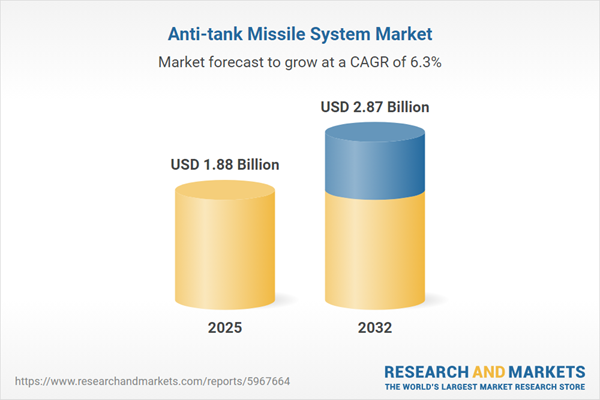Speak directly to the analyst to clarify any post sales queries you may have.
Senior decision-makers navigating the anti-tank missile system market encounter rapid technological change and increased complexity, demanding a proactive approach to procurement and strategic modernization. The market’s shifting landscape calls for solutions that enhance force effectiveness while ensuring operational adaptability across diverse defense environments.
Market Snapshot: Trends Shaping the Anti-Tank Missile System Market
The anti-tank missile system market is positioned for substantial growth, expanding from USD 1.77 billion in 2024 to USD 1.88 billion in 2025, and projected to reach USD 2.87 billion by 2032. This trajectory equates to a compound annual growth rate (CAGR) of 6.25%. Key drivers include the deployment of advanced defense technologies, dynamic procurement models, and ongoing modernization efforts among both suppliers and military procurement agencies. Defense organizations are investing in next-generation system architectures and capability upgrades to address increasingly complex battlefield threats. Rising system sophistication is central to global defense readiness, as supply chains and agencies prioritize rapid integration of superior missile solutions.
Scope & Segmentation: Strategic Analysis for the Anti-Tank Missile System Market
Segmentation within the anti-tank missile system market allows organizations to align investments and modernization strategies to their operational demands. By evaluating a range of specifications, procurement stakeholders optimize resource planning and respond to mission priorities. Regional adoption rates and technology integration differences further shape defense approaches around the world.
- Guidance Type: Dual mode, fire-and-forget, imaging infrared, radar, laser, radio, and wire-guided technologies support adaptive deployment and operational flexibility for varied battlefield conditions.
- Warhead Type: Blast fragmentation, shaped charge, and tandem warhead options increase engagement versatility, equipping forces to counter modern armor and adapt to evolving threat scenarios.
- Platform Type: Helicopter-launched, man-portable, and vehicle-mounted platforms enable seamless system integration across infantry, mechanized, and airborne divisions, contributing to force structure versatility.
- Propulsion Type: Hybrid rocket, recoilless, and solid propellant systems balance logistical requirements with enhanced performance, supporting sustained operations and tactical responsiveness.
- Range: Solutions span short, medium, and long-range capabilities, allowing defense planners to tailor system performance to specific operational theaters and mission requirements.
- End User: Armies, paramilitary units, and special forces drive system innovation, selecting solutions that address precise tactical goals and operational needs.
- Regions: The Americas, Europe, Middle East & Africa, and Asia-Pacific present distinct procurement strategies and modernization objectives, underpinned by localized security priorities and geopolitical considerations.
- Key Companies: Leading industry participants such as Lockheed Martin Corporation, Raytheon Technologies Corporation, MBDA France SAS, Rafael Advanced Defense Systems Ltd, Thales SA, BAE Systems plc, Northrop Grumman Corporation, Kongsberg Gruppen ASA, China North Industries Group Corporation Limited, and Hanwha Defense Co., Ltd contribute to ongoing technological advancement and sector growth.
Key Takeaways: Actionable Insights for Senior Leaders
- Modular system designs and advanced guidance technology support tailored configurations for enhanced mission flexibility and rapid response capability.
- Integrated survivability and robust system resilience are essential in contested environments, underpinning reliable performance against electronic warfare and active threats.
- Interoperability across land, air, and mobile platforms simplifies logistics, supporting coordinated operations and operational agility for multi-theater campaigns.
- Adoption of open-system architectures lowers upgrade costs over the system lifecycle and accelerates integration of emerging technologies, making modernization sustainable.
- Collaborative innovation with defense research organizations accelerates the adoption of AI-enabled targeting and automation for improved targeting precision.
- Regional procurement strategies reinforce supply chain reliability in Western markets and enable swift adoption and production in Asia-Pacific, advancing capability development worldwide.
Tariff Impact: Addressing Supply Chain and Pricing Pressures
Recent changes to U.S. tariff policy have influenced manufacturers’ approaches to supply chain management, prompting increased diversification and local manufacturing. These adjustments bolster supply continuity, safeguard procurement timelines, and help mitigate worldwide disruptions. Strengthened industrial partnerships support the stability of long-term investments in anti-tank missile technology.
Methodology & Data Sources
This report integrates quantitative market insights with expert analysis, drawing from procurement professionals, technical documentation, and targeted research. The result delivers relevant, actionable data to inform strategic procurement and modernization decisions.
Why This Report Matters
- Enables senior procurement leaders to identify solutions that are scalable, adaptable, and aligned with both immediate requirements and future mission objectives.
- Reduces exposure to supply and security risks through detailed, region-specific insights that support tailored operational planning.
- Outlines acquisition models and partnership approaches that streamline modernization processes and boost overall force flexibility.
Conclusion
This analysis equips senior defense leaders with concrete insights for optimizing procurement strategies, enabling force modernization, and supporting sustained readiness in the complex anti-tank missile system market.
Additional Product Information:
- Purchase of this report includes 1 year online access with quarterly updates.
- This report can be updated on request. Please contact our Customer Experience team using the Ask a Question widget on our website.
Table of Contents
3. Executive Summary
4. Market Overview
7. Cumulative Impact of Artificial Intelligence 2025
Companies Mentioned
The companies profiled in this Anti-tank Missile System market report include:- Lockheed Martin Corporation
- Raytheon Technologies Corporation
- MBDA France SAS
- Rafael Advanced Defense Systems Ltd
- Thales SA
- BAE Systems plc
- Northrop Grumman Corporation
- Kongsberg Gruppen ASA
- China North Industries Group Corporation Limited
- Hanwha Defense Co., Ltd
Table Information
| Report Attribute | Details |
|---|---|
| No. of Pages | 198 |
| Published | October 2025 |
| Forecast Period | 2025 - 2032 |
| Estimated Market Value ( USD | $ 1.88 Billion |
| Forecasted Market Value ( USD | $ 2.87 Billion |
| Compound Annual Growth Rate | 6.2% |
| Regions Covered | Global |
| No. of Companies Mentioned | 11 |









